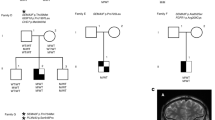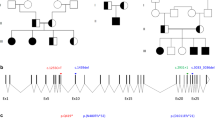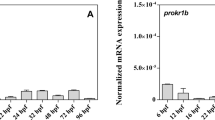Abstract
Kallmann syndrome (KS) is a disorder characterized by hypogonadotropic hypogonadism and anosmia. Although KS is genetically heterogeneous, only two causal genes have been identified to date. These include an X-linked gene that encodes anosmin 1 and an autosomal gene that encodes fibroblast growth factor receptor 1. Mutations in these two genes result in disorders that often include, but are not limited to, severe defects in olfactory and reproductive functions. In this respect, KS can be regarded as a 'human model' for understanding critical factors that regulate olfactory and reproductive development. Here we give an overview of the disorders that stem from mutations in these two genes, with special emphasis on the cellular mechanisms underlying olfactory and reproductive anomalies. Other, less well-known aspects of KS, such as the convergence of symptoms in patients with different genetic forms of KS and the unpredictable manifestation of KS symptoms, are also discussed.
Key Points
-
Kallmann syndrome (KS) is characterized by hypogonaotropic hypogonadism and anosmia; it can occur sporadically or be inherited as X-linked, autosomal dominant or autosomal recessive forms
-
Mutations in KAL1, which encodes the glycoprotein anosmin-1 in embryonic extracellular matrix, cause the X-linked form
-
Limited human embryonic data indicate that KAL1 mutations lead to defects in gonadotropin-releasing hormone (GnRH) neuronal migration secondary to aberrant olfactory axon growth
-
Mutations in the gene encoding fibroblast growth factor receptor 1 (FGFR1) can cause the autosomal dominant form
-
Data from a transgenic mouse model indicate that mutations in FGFR1 can directly affect GnRH neuronal birth, migration, and axon targeting, leading to diverse defects in the GnRH system
-
Overall, mutations in these two genes account for 20% of KS, but the phenotype of KS is variable and cannot be predicted simply from knowledge of the mutated genes
This is a preview of subscription content, access via your institution
Access options
Subscribe to this journal
Receive 12 print issues and online access
$209.00 per year
only $17.42 per issue
Buy this article
- Purchase on Springer Link
- Instant access to full article PDF
Prices may be subject to local taxes which are calculated during checkout



Similar content being viewed by others
References
Jones JR and Kemmann E (1976) Olfacto-genital dysplasia in the female. Obstet Gynecol Annu 5: 443–466
Fromantin M et al. (1973) Impuberism and hypogonadism at induction into military service. Statistical study [French]. Probl Actuels Endocrinol Nutr 16: 179–199
Franco B et al. (1991) A gene deleted in Kallmann's syndrome shares homology with neural cell adhesion and axonal path-finding molecules. Nature 353: 529–536
Legouis R et al. (1991) The candidate gene for the X-linked Kallmann syndrome encodes a protein related to adhesion molecules. Cell 67: 423–435
Dodé C et al. (2003) Loss-of-function mutations in FGFR1 cause autosomal dominant Kallmann syndrome. Nat Genet 33: 463–465
Bulow HE et al. (2002) Heparan sulfate proteoglycan-dependent induction of axon branching and axon misrouting by the Kallmann syndrome gene kal-1. Proc Natl Acad Sci USA 99: 6346–6351
Gonzalez-Martinez D et al. (2004) Anosmin 1 modulates fibroblast growth factor receptor 1 signaling in human gonadotropin-releasing hormone olfactory neuroblasts through a heparan sulfate-dependent mechanism. J Neurosci 24: 10384–10392
Hebert JM et al. (2003) FGF signaling through FGFR1 is required for olfactory bulb morphogenesis. Development 130: 1101–1111
Rugarli EI et al. (2002) The Kallmann syndrome gene homolog in C. elegans is involved in epidermal morphogenesis and neurite branching. Development 129: 1283–1294
Hardelin JP et al. (1999) Anosmin 1 is a regionally restricted component of basement membranes and interstitial matrices during organogenesis: implications for the developmental anomalies of X chromosome-linked Kallmann syndrome. Dev Dyn 215: 26–44
del Castillo I et al. (1992) Structure of the X-linked Kallmann syndrome gene and its homologous pseudogene on the Y chromosome. Nat Genet 2: 305–310
Hu Y et al. (2004) Cross-talk of anosmin-1, the protein implicated in X-linked Kallmann's syndrome, with heparan sulphate and urokinase-type plasminogen activator. Biochem J 384: 495–505
Robertson A et al. (2001) Molecular modelling and experimental studies of mutation and cell-adhesion sites in the fibronectin type III and whey acidic protein domains of human anosmin-1. Biochem J 357: 647–659
Hu Y et al. (2005) Extended and flexible domain solution structure of the extracellular matrix protein anosmin-1 by X-ray scattering, analytical ultracentrifugation and constrained modelling. J Mol Biol 350: 553–570
Oliveira LM et al. (2001) The importance of autosomal genes in Kallmann syndrome: genotype-phenotype correlations and neuroendocrine characteristics. J Clin Endocrinol Metab 86: 1532–1538
Groth C and Lardelli M (2002) The structure and function of vertebrate fibroblast growth factor receptor 1. Int J Dev Biol 46: 393–400
Yaylaoglu MB et al. (2005) Comprehensive expression atlas of fibroblast growth factors and their receptors generated by a novel robotic in situ hybridization platform. Dev Dyn 234: 371–386
Mohammadi M et al. (2005) Structural basis for fibroblast growth factor receptor activation. Cytokine Growth Factor Rev 16: 107–137
Dodé C and Hardelin JP (2004) Kallmann syndrome: fibroblast growth factor signaling insufficiency? J Mol Med 82: 725–734
Albuisson J et al. (2005) Kallmann syndrome: 14 novel mutations in KAL1 and FGFR1 (KAL2). Hum Mutat 25: 98–99
Maya-Nunez G et al. (1999) An atypical contiguous gene syndrome: molecular studies in a family with X-linked Kallmann's syndrome and X-linked ichthyosis. Clin Endocrinol (Oxf) 50: 157–162
Sato N et al. (2004) Clinical assessment and mutation analysis of Kallmann syndrome 1 (KAL1) and fibroblast growth factor receptor 1 (FGFR1, or KAL2) in five families and 18 sporadic patients. J Clin Endocrinol Metab 89: 1079–1088
Ibrahimi O et al. (2004) Proline to arginine mutations in FGF receptors 1 and 3 result in Pfeiffer and Muenke craniosynostosis syndromes through enhancement of FGF binding affinity. Hum Mol Genet 13: 69–78
Muenke M et al. (1994) A common mutation in the fibroblast growth factor receptor 1 gene in Pfeiffer syndrome. Nat Genet 8: 269–274
Wilkie AO (2005) Bad bones, absent smell, selfish testes: the pleiotropic consequences of human FGF receptor mutations. Cytokine Growth Factor Rev 16: 187–203
Rapraeger AC et al. (1991) Requirement of heparan sulfate for bFGF-mediated fibroblast growth and myoblast differentiation. Science 252: 1705–1708
Yayon A et al. (1991) Cell surface, heparin-like molecules are required for binding of basic fibroblast growth factor to its high affinity receptor. Cell 64: 841–848
Klingmuller D et al. (1987) Magnetic resonance imaging of the brain in patients with anosmia and hypothalamic hypogonadism (Kallmann's syndrome). J Clin Endocrinol Metab 65: 581–584
Quinton R et al. (1996) The neuroradiology of Kallmann's syndrome: a genotypic and phenotypic analysis. J Clin Endocrinol Metab 81: 3010–3017
Quinton R et al. (2001) Idiopathic gonadotrophin deficiency: genetic questions addressed through phenotypic characterization. Clin Endocrinol (Oxf) 55: 163–174
Waldstreicher J et al. (1996) The genetic and clinical heterogeneity of gonadotropin-releasing hormone deficiency in the human. J Clin Endocrinol Metab 81: 4388–4395
Pitteloud N et al. (2005) Reversible Kallmann syndrome, delayed puberty, and isolated anosmia occurring in a single family with a mutation in the fibroblast growth factor receptor 1 gene. J Clin Endocrinol Metab 90: 1317–1322
Hardelin JP et al. (1993) Xp22.3 deletions in isolated familial Kallmann's syndrome. J Clin Endocrinol Metab 76: 827–831
Parenti G et al. (1995) Variable penetrance of hypogonadism in a sibship with Kallmann syndrome due to a deletion of the KAL gene. Am J Med Genet 57: 476–478
Hardelin JP (2001) Kallmann syndrome: towards molecular pathogenesis. Mol Cell Endocrinol 179: 75–81
Birnbacher R et al. (1994) Diagnosis of X-recessive Kallmann syndrome in early infancy. Evidence of hypoplastic rhinencephalon. Eur J Pediatr 153: 245–247
Hayes FJ et al. (1991) Gonadotropin-releasing hormone deficiency: differential diagnosis and treatment. Endocrinologist 9: 36–44
Crowley WF and Whitcomb RW (1990) Gonadotropin-releasing hormone deficiency in men: diagnosis and treatment with exogenous gonadotropin-releasing hormone. Am J Obstet Gynecol 163: 1752–1758
Santoro N et al. (1986) Hypogonadotropic disorders in men and women: diagnosis and therapy with pulsatile gonadotropin-releasing hormone. Endocr Rev 7: 11–23
Berezin M et al. (1988) Successful GnRH treatment in a patient with Kallmann's syndrome, who previously failed HMG/HCG treatment. Andrologia 20: 285–288
Liu L et al. (1988) Two-year comparison of testicular responses to pulsatile gonadotropin-releasing hormone and exogenous gonadotropins from the inception of therapy in men with isolated hypogonadotropic hypogonadism. J Clin Endocrinol Metab 67: 1140–1145
Martin KA et al. (1993) Comparison of exogenous gonadotropins and pulsatile gonadotropin-releasing hormone for induction of ovulation in hypogonadotropic amenorrhea. J Clin Endocrinol Metab 77: 125–129
Schwanzel-Fukuda M et al. (1989) Luteinizing hormone-releasing hormone (LHRH)-expressing cells do not migrate normally in an inherited hypogonadal (Kallmann) syndrome. Brain Res Mol Brain Res 6: 311–326
Soussi-Yanicostas N et al. (1998) Anosmin-1 underlying the X chromosome-linked Kallmann syndrome is an adhesion molecule that can modulate neurite growth in a cell-type specific manner. J Cell Sci 111: 2953–2965
Soussi-Yanicostas N et al. (2002) Anosmin-1, defective in the X-linked form of Kallmann syndrome, promotes axonal branch formation from olfactory bulb output neurons. Cell 109: 217–228
Soussi-Yanicostas N et al. (1996) Initial characterization of anosmin-1, a putative extracellular matrix protein synthesized by definite neuronal cell populations in the central nervous system. J Cell Sci 109: 1749–1757
Tumova S et al. (2000) Heparan sulfate proteoglycans on the cell surface: versatile coordinators of cellular functions. Int J Biochem Cell Biol 32: 269–288
Gong Q and Shipley MT (1995) Evidence that pioneer olfactory axons regulate telencephalon cell cycle kinetics to induce the formation of the olfactory bulb. Neuron 14: 91–101
Gonzalez-Martinez D et al. (2004) Ontogeny of GnRH and olfactory neuronal systems in man: novel insights from the investigation of inherited forms of Kallmann's syndrome. Front Neuroendocrinol 25: 108–130
MacColl G et al. (2002) GnRH neuronal development: insights into hypogonadotrophic hypogonadism. Trends Endocrinol Metab 13: 112–118
Massin N et al. (2003) X chromosome-linked Kallmann syndrome: clinical heterogeneity in three siblings carrying an intragenic deletion of the KAL1 gene. J Clin Endocrinol Metab 88: 2003–2008
Deng CX et al. (1994) Murine FGFR-1 is required for early postimplantation growth and axial organization. Genes Dev 8: 3045–3057
Yamaguchi TP et al. (1994) Fgfr-1 is required for embryonic growth and mesodermal patterning during mouse gastrulation. Genes Dev 8: 3032–3044
Meyers EN et al. (1998) An Fgf8 mutant allelic series generated by Cre- and Flp-mediated recombination. Nat Genet 18: 136–141
LaMantia AS et al. (2000) Mesenchymal/epithelial induction mediates olfactory pathway formation. Neuron 28: 411–425
Gill JC et al. (2004) Developmental regulation of gonadotropin-releasing hormone neurons by fibroblast growth factor signaling. Endocrinology 145: 3830–3839
Tsai PS et al. (2005) Targeted expression of a dominant-negative fibroblast growth factor (FGF) receptor in gonadotropin-releasing hormone (GnRH) neurons reduces FGF responsiveness and the size of GnRH neuronal population. Mol Endocrinol 19: 225–236
Gill JC and Tsai PS Expression of a dominant negative fibroblast growth factor receptor in developing gonadotropin-releasing hormone neurons disrupts axon outgrowth and targeting to the median eminence. Biol Reprod, in press
Rosini P et al. (2002) Androgen receptor expression induces FGF2, FGF-binding protein production, and FGF2 release in prostate carcinoma cells: role of FGF2 in growth, survival, and androgen receptor down-modulation. Prostate 53: 310–321
Ruohola JK et al. (1995) Androgen and fibroblast growth factor (FGF) regulation of FGF receptors in S115 mouse mammary tumor cells. Endocrinology 136: 2179–2188
Bulow HE and Hobert O (2004) Differential sulfations and epimerization define heparan sulfate specificity in nervous system development. Neuron 41: 723–736
Williams FJ et al. (1994) Activation of the FGF receptor underlies neurite outgrowth stimulated by L1, N-CAM, and N-cadherin. Neuron 13: 583–594
Doherty P and Walsh FS (1996) CAM-FGF receptor interactions: A model for axonal growth. Mol Cell Neurosci 8: 99–111
Kiselyov V et al. (2003) Structural basis for a direct interaction between FGFR1 and NCAM and evidence for a regulatory role of ATP. Structure 11: 691–701
Gu WX et al. (1998) A novel aminoterminal mutation in the KAL-1 gene in a large pedigree with X-linked Kallmann syndrome. Mol Genet Metab 65: 59–61
Soderlund D et al. (2002) Identification of three novel mutations in the KAL1 gene in patients with Kallmann syndrome. J Clin Endocrinol Metab 87: 2589–2592
Izumi Y et al. (2001) Analysis of the KAL1 gene in 19 Japanese patients with Kallmann syndrome. Endocr J 48: 143–149
Nagata K et al. (2000) A novel interstitial deletion of KAL1 in a Japanese family with Kallmann syndrome. J Hum Genet 45: 237–240
Trarbach E et al. (2004) Similar interstitial deletions of the KAL-1 gene in two Brazilian families with X-linked Kallmann syndrome. Gen Mol Biol 27: 337–341
Hardelin JP et al. (1992) X chromosome-linked Kallmann syndrome: stop mutations validate the candidate gene. Proc Natl Acad Sci USA 89: 8190–8204
O'Neill MJ et al. (1998) Familial Kallmann syndrome: a novel splice acceptor mutation in the KAL gene. Hum Mutat 11: 340–342
Loidi L et al. (2005) Kallmann's syndrome with a novel missense mutation in the KAL1 gene that modifies the major cell adhesion site of the anosmin-1 protein. J Pediatr Endocrinol Metab 18: 545–548
Hardelin JP et al. (1993) Heterogeneity in the mutations responsible for X chromosome-linked Kallmann syndrome. Hum Mol Genet 2: 373–377
Matsuo T et al. (2000) A novel mutation of the KAL1 gene in monozygotic twins with Kallmann syndrome. Eur J Endocrinol 143: 783–787
Georgopoulos NA et al. (1997) Genetic heterogeneity evidenced by low incidence of KAL1 gene mutations in sporadic cases of gonadotropin-releasing hormone deficiency. J Clin Endocrinol Metab 82: 213–217
Jansen C et al. (2000) A novel nonsense mutation of the KAL gene in two brothers with Kallmann syndrome. Horm Res 53: 207–212
Bick D et al. (1992) Brief report: intragenic deletion of the KALIG1 gene in Kallmann's syndrome. N Engl J Med 326: 1752–1755
Sato N et al. (2005) Gonadotrophin therapy in Kallmann syndrome caused by heterozygous mutations of the gene for fibroblast growth factor receptor 1: report of three families: case report. Hum Reprod 20: 2173–2178
Müller F and O'Rahilly R (2004) Olfactory structures in staged human embryos. Cells Tissues Organs 178: 93–116
Acknowledgements
This work was supported by NIH grants RO1 HD042634 and F31 HD47991.
Author information
Authors and Affiliations
Corresponding author
Ethics declarations
Competing interests
The authors declare no competing financial interests.
Rights and permissions
About this article
Cite this article
Tsai, PS., Gill, J. Mechanisms of Disease: insights into X-linked and autosomal-dominant Kallmann syndrome. Nat Rev Endocrinol 2, 160–171 (2006). https://doi.org/10.1038/ncpendmet0119
Received:
Accepted:
Issue Date:
DOI: https://doi.org/10.1038/ncpendmet0119
This article is cited by
-
Extracellular matrix protein anosmin-1 overexpression alters dopaminergic phenotype in the CNS and the PNS with no pathogenic consequences in a MPTP model of Parkinson’s disease
Brain Structure and Function (2023)
-
Expanding the mutational spectrum of monogenic hypogonadotropic hypogonadism: novel mutations in ANOS1 and FGFR1 genes
Reproductive Biology and Endocrinology (2020)
-
Copy number variation associated with Kallmann syndrome: new genetics insights from genome-wide studies
Asian Journal of Andrology (2011)
-
Kallmann syndrome
European Journal of Human Genetics (2009)
-
Kallmann-Syndrom
Der Nervenarzt (2009)



